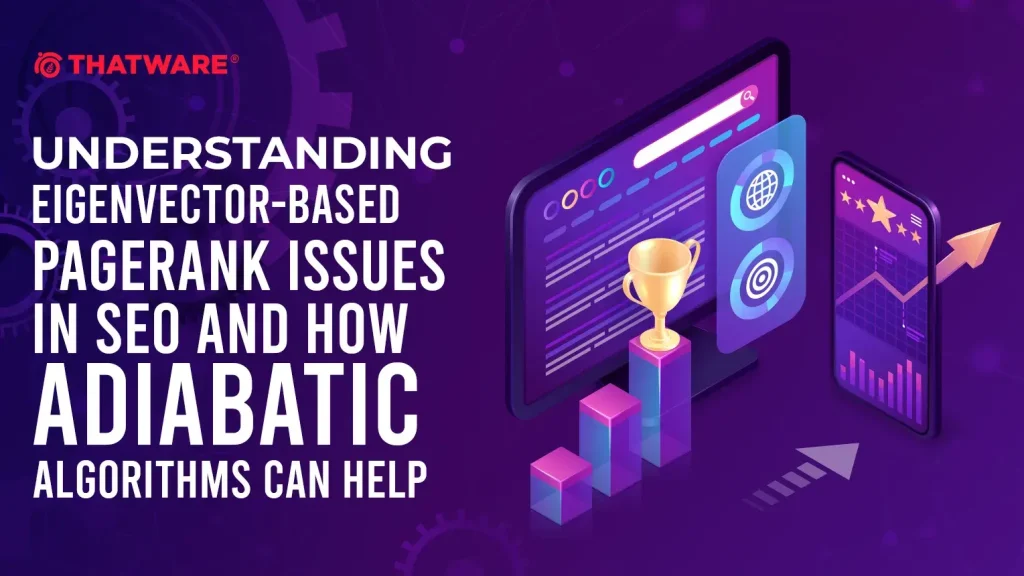Get a Customized Website SEO Audit and Quantum SEO Marketing Strategy and Action Plan
When Google first introduced PageRank, it completely changed how the web was navigated. For the first time, search engines could evaluate the relative importance of a web page not just by counting its links, but by understanding how those links passed on authority. The mathematics behind this ranking system relied on a principle called eigenvector centrality.

In simple terms, this means that a page’s value isn’t just determined by how many links it receives, but by who those links come from. A vote from a well-connected, highly regarded site is worth far more than one from an obscure page. This approach, powered by eigenvectors, became the backbone of early search ranking strategies and is still embedded in how many algorithms work today.
What Does Eigenvector-Based PageRank Actually Mean?
To understand it without drowning in formulas, imagine the internet as a giant map of connected cities. Each city is a web page, and roads between them are hyperlinks. Eigenvector centrality is a way to measure which cities are most important based not only on how many roads lead there, but also on whether those roads come from other well-connected cities.
Mathematically, it works like this:
P × x = λx
- P is the transition matrix — a giant table that shows the probability of moving from one page to another through a link.
- x is the eigenvector — a list of scores showing the relative importance of each page.
- λ is the eigenvalue — often set to 1 to keep the results stable.
This calculation is repeated over and over until the scores stop changing much, producing a stable “importance map” of the web.
Current Issues with Eigenvector PageRank in SEO
The eigenvector-based PageRank model has long been admired for its mathematical precision, but in the real-world landscape of SEO, it is beginning to show its age. The problem isn’t that the math is wrong—it’s that the web, user behavior, and search algorithms have evolved far beyond what the original model anticipated. For sites that are large, complex, or constantly changing, these limitations can quietly erode search performance.
1. Link Structure Bias
The classic PageRank formula assumes that every link has an equal chance of being followed, which sounds fair in theory. In practice, this can cause distortions. Sites with spammy link clusters, isolated “orphan” pages, or circular link loops can end up with inflated or misleading authority scores. This skews priority away from genuinely valuable pages and can trick your analytics into thinking the site is healthier than it is.
2. A Static View of a Moving Target
When you calculate an eigenvector, you are freezing a moment in time—a snapshot of the link graph. But the web doesn’t stand still. Pages are created, links are updated, and old content disappears every day. That lag between a static calculation and the constantly shifting reality means PageRank values can become outdated faster than you can act on them.
3. Missing the Context Behind the Links
Eigenvector PageRank measures the raw popularity of links, not the meaning behind them. It doesn’t recognize if a link is topically relevant to the content, whether it aligns with user intent, or how it fits into semantic search relationships. In modern SEO, those contextual signals are often the deciding factors in whether a page ranks well.
4. Scalability and Delays at Large Scale
On massive sites with millions of internal and external links, calculating the principal eigenvector is no small feat. The computing power and time required can lead to noticeable delays. This slows down how quickly you can adapt your SEO strategy, update your linking architecture, or react to search engine algorithm changes.
SEO Challenges Created by These Limitations
These technical constraints translate directly into operational headaches for SEO teams:
- Crawl budget inefficiency – Pages that truly matter might get overlooked simply because they have fewer incoming links.
- Weak internal linking guidance – Recommendations end up driven by link counts rather than link value or relevance.
- Slow adaptation to search updates – Without real-time recalculation, your site may lag behind algorithm shifts.
- Loss of authority in hidden corners – Orphaned or deep-linked pages often stay buried, never reclaiming their potential value in the site’s overall authority flow.
The bottom line is that while eigenvector-based PageRank remains an elegant piece of math, its blind spots can undermine SEO efforts if used without additional layers of contextual and real-time analysis. Modern optimization requires a model that understands both the structure and the meaning of the web—and can adapt as quickly as the web itself changes.
Enter Adiabatic Algorithms: A Quantum-Inspired Approach to Smarter PageRank
Over the past few years, adiabatic quantum computing has moved from the research lab into serious discussions about how we tackle large, complex problems. One area where its methods shine is in graph-based systems like Google’s PageRank. Instead of relying solely on fixed, repetitive calculations, these quantum-inspired techniques bring a more fluid, adaptive way to understand how authority flows across the web.
What Are Adiabatic Algorithms?
Think of an adiabatic algorithm as a patient problem-solver. It starts with a simple quantum system whose solution is easy to find. Then, step by step, it transforms that system into one that represents a much more complicated problem—such as calculating PageRank for billions of interconnected pages. The magic here is in the smoothness: the system changes gradually, so it never has to “jump” between possible answers. This approach makes it naturally suited to optimization tasks, especially in environments where every node (or page) influences every other in subtle ways.
How Adiabatic Algorithms Can Improve PageRank
1. Real-Time Adaptation to Change
Traditional PageRank treats the web like a static photograph. Adiabatic algorithms treat it more like a live video feed. As links are added, removed, or updated, the algorithm adjusts seamlessly, making it possible to refresh rankings quickly without recalculating everything from scratch. For fast-moving websites—think news portals, e-commerce platforms, or active blogs—this agility is invaluable.
2. More Resilient Authority Flow
One challenge in PageRank is that small changes or noisy data can skew results. Adiabatic algorithms are built to work within “energy landscapes,” which naturally account for weight, influence, and entropy. In practice, that means the ranking system becomes less sensitive to spammy links or sudden link drops, and more focused on steady, meaningful signals.
3. Faster Convergence on Large Graphs
When you’re dealing with millions—or billions—of pages, speed matters. Adiabatic methods can reach stable importance scores more quickly than classical linear models. For SEO teams managing massive site architectures, that means you can test, tweak, and roll out internal linking improvements in something close to real time.
4. Smarter Contextual Understanding
Modern search engines don’t just care if a page has links—they care about the context of those links. By combining link strength, placement, and frequency with quantum-inspired “potential fields,” adiabatic algorithms create a richer picture of relevance. This leads to rankings that better reflect topical authority, user intent, and semantic relationships.
Visualizing the Shift: Eigenvector PageRank vs. Adiabatic Flow
Think of it like comparing two maps of a city’s traffic flow.
On the left, the Eigenvector-based PageRank diagram captures a fixed street grid where cars (representing authority) travel at the same pace on every road. No matter what’s happening in the city—rush hour, construction, or a big event—the traffic pattern stays the same. It’s predictable but doesn’t react to the real world.
On the right, the Adiabatic Algorithm diagram tells a different story. Here, the roads change in importance depending on what’s happening in real time. Some streets may suddenly get more traffic because they connect to high-value areas, while others slow down because they’re less relevant to the current flow. This mirrors the way authority moves between web pages when the model accounts for context, link frequency, and changing relationships over time.
The key difference? One is a static snapshot. The other is a living, breathing model that adapts as conditions change.
How to Begin Applying These Concepts in SEO Today
Full-scale quantum computing in SEO is still in the experimental phase, but quantum-inspired algorithms can already be modeled using conventional hardware. Forward-thinking SEO teams can start building the foundation for this shift now:
1. Build a Quantum-Ready Data Framework
Organize your crawl data and internal linking structure as a graph database, such as Neo4j or TigerGraph. This makes it easier to integrate with future quantum simulations and to run more sophisticated link analysis today.
2. Use More Sophisticated Centrality Models
Move beyond the classic PageRank calculation. Experiment with hybrid models that combine eigenvector-based authority scoring with topic-sensitive and semantic-aware adjustments. This allows your site’s link structure to better reflect relevance in addition to raw connectivity.
3. Simulate Adiabatic-Like Authority Flows
While you can’t yet run this on a true quantum machine at scale, you can use tools like D-Wave’s Ocean SDK or IBM’s Qiskit to model dynamic authority shifts. These simulations let you test how adding, removing, or restructuring internal links could influence how authority travels through your site.
Why This Matters for the Future of SEO
The original PageRank revolutionized search ranking by mapping the web’s structure mathematically. But the internet it was designed for no longer exists. Today’s sites are massive, interconnected, and constantly changing. A purely static model struggles to capture these dynamics.
Adiabatic-inspired algorithms bring us closer to a real-time view of authority flow, making them better suited to the way modern search engines interpret and rank content. For large eCommerce platforms, news outlets, or SaaS ecosystems, this could mean more precise authority distribution and better ranking potential.

